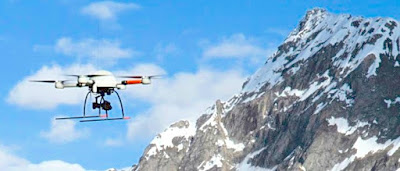“In order to realize the true value of a drone’s capabilities,
Drone Pilots and SAR authorities from the Incident Commander (IC) on down need
to gain experience by employing drones on actual SAR operations and in training. Only then will you realize that drones provide another tool in the toolbox
for the Incident Commanders that can and will prove invaluable”
Drones have quickly become the most widely used tool for
many industries. From Police and Fire Departments to agriculture and energy operations,
drones have become essential to boosting safety and productivity.
A search and rescue drone used by emergency services, such
as police officers, firefighters or volunteer rescue teams, is ideal for searching
over vast areas for missing persons and crime victims in need of rescue and in
any environment. Search times can be
significantly reduced while limiting potential risk to the party being rescued
as well as rescuers. There are many options and benefits to using drones for
search and rescue.
Thermal imaging or forward-looking infrared (FLIR) is a
major benefit for search and rescue. Body heat naturally makes humans stand
out from plant life, making them easy to spot very quickly. Most thermal cameras also have the option to
change temperature search range and the color palette for a wide variety of options to make sure you can see
exactly what you’re looking for.
Almost all commercial drones come equipped with GPS,
allowing the pilot to offer rescue teams the exact GPS coordinates of the
subjects once they have been spotted. With the live view feature of any
drone used for search and rescue, the pilot can also guide rescue crews to
their location.
There is no point sending any aircraft into the air for SAR
if the visuals can’t be relayed to the ground search team or incident command as is often the case for manned aviation. Many drones have the capability to stream live video from
the controller to a monitor for on-site viewing or to a broadcast
terminal to send to a remote incident command center on a larger monitor for easier identification of subjects in real-time.
This allows pilots or incident command crews to guide rescue teams to
the precise location of their subjects, and the aerial view also aids in guiding those crews around any obstacles or hazards that may be in
their path.
Too find out more on how you can develop a drone program for
your search and rescue organization, contact Dave Crago at cragod1@gmail.com
Do you have a story of drones coming to the rescue or
assisting your agency? Please share in the comments.





My agency just hired an instructor to teach a SAR class and it was obvious that he had no clue how to utilize drones within our program and or SAR in general. Thanks for the post.
ReplyDeleteThanks for sharing nice information with us. i like your post and all you share with us is uptodate and quite informative, i would like to bookmark the page so i can come here again to read you, as you have done a wonderful job. commercial drones
ReplyDelete